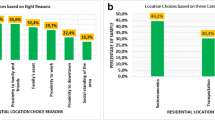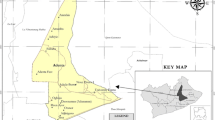Abstract
This paper assesses the determinants of households’ residential location decision in the Adenta Municipality. Using a total sample of 194 respondents selected from the 18 communities in the Municipality, a multi-stage sampling procedure and google-earth images; the paper concludes that neighbourhood welfare, accessibility attributes, comfort levels of the households and the overall housing conditions are the major determinants which influence household residential location choices in the study area. The paper recommends among others that neighbourhood characteristics such as security of vicinity, proximity to access road, house types, proximity to work and noise levels should be given the necessary attention in the development of urban communities such as Adenta in Ghana.

Similar content being viewed by others
References
Adenta Municipal Assembly. (2013). The medium term development plan, 2010–2013. Accra: Adenta Municipal Assembly.
Alonso, W. (1960). A theory of the urban land market. Papers in Regional Science Association, 6(1), 149–157.
Alonso, W. (1964). Location and land use. Cambridge, MA: Harvard University Press.
Batty, M. (1976). Urban modelling: Algorithms, calibrations, predictions. Cambridge: Cambridge University Press.
Batty, M. (1994). A chronicle of scientific planning: The Anglo-American modelling experience. Journal of the American Institute of Planners, 60(1), 7–16.
Ben-Akiva, M. E., & Bowman, J. L. (1998). Integration of an activity-based model system and a residential location model. Urban Studies, 35(7), 1131–1153.
Ben-Akiva, M. E., & Lerman, S. R. (1985). Discrete choice analysis: Theory and application to travel demand (Vol. 9). Cambridge: MIT press.
Bertuglia, C. S., Leonardi, G., Occelli, S., Rabino, G. A., Tadei, R., & Wilson, A. G. (Eds.). (1987). Urban systems: Contemporary approaches to modelling. London: Croom Helm.
Bossard, J. H. S. (1932). Residential propinquity as a factor in marriage selection. American Journal of Sociology, 38, 219–244.
Burgess, E. W. (1927). The determinants of gradients in the growth of a city. American Sociology Review, 21, 178–184.
Carrothers, G. A. P. (1956). An historical review of the gravity and potential concepts of human interaction. Journal of the American Institute of Planners, 22(2), 94–102.
Chen, J., Chen, C., & Timmersmans, H. (2008). Accessibility trade-offs in household residential location decision. Transportation Research Record: Journal of the Transportation Research Board, 2077(1), 71–79.
Clark, W. A. V., & Withers, S. D. (1999). Changing jobs and changing houses: Mobility outcomes of employment transitions. Journal of Regional Science, 39(4), 653-673.
Frenkel, A., Bendit, E., & Kaplan, S. (2013). Residential location choice of knowledge workers: The role of amenities, workplace and lifestyle. Cities, 35, 33–41.
Gayda, S. (1998). Stated preference survey on residential location choice and modal choice in brussels. Paper presented at the world conference on transportation research, Antwerpen.
Ghana Statistical Service. (2012). 2010 Housing and population census. Summary report of final results. Accra: Ghana Statistical Service.
Ghana Statistical Service. (2014). 2010 Housing and population census. District analytical report—Adentan Municipality. Accra: Ghana Statistical Service.
Guevara, C., & Ben-Akiva, M. E. (2006). Endogeneity in residential location choice models. Transportation research record No. 1977 (pp. 60–66).
Gyimah, S. O.-M. (2001). Residential location and intra city mobility in an African City: Some empirical observations among migrants in metropolitan Accra, Ghana. PSC Discussion Papers Series, 15(15), Article 1. http://ir.lib.uwo.ca/pscpapers/vol15/iss15/1.
Harris, C. D., & Ullman, E. L. (1945). The nature of cities. Annals of the American Academy of Political and Social Science, 242(1), 7–17.
Hoyt, H. (1939). The structure and growth of residential neighbourhoods in American cities. Washington, D.C.: Federal Housing Administration.
Huff, D. L. (1964). Defining and estimating a trading area. The Journal of Marketing, 28(3), 34–38.
Hunt, J. D, McMillan, D. P., & Abraham, J. E. (1994). A stated preference investigation of influences of the attractiveness of the residential locations. Transportation research record 1466 (pp. 79–87).
Ikle, F. C. (1954). Sociological relationship of traffic to population and distance. Traffic Quarterly, 8(2), 123–136.
Kiefer, Hua. (2012). Residential location choice: The role of taste for similarity. International Journal of Economics and Finance, 4(9), 34–60.
Kim, J., Francesca, Pagliara, & Preston, John. (2015). The intention to move and residential location choice behaviour. Urban Studies, 42(9), 1621–1636.
Lakshmanan, T. R., & Hansen, W. G. (1965). A retail market potential model. Journal of the American Institute of Planners, 31(2), 134–143.
Lee, B. H. Y, & Waddell, P. A. (2010). Residential mobility and location choices: A nested logit model with sampling of alternatives. Transportation, 37(4), 587–601.
Lowry, I. S. (1964). A model of metropolis, RM-4035-RC. Santa Monica, CA: The Rand Corporation.
Mahama, Callistus. (2006). Property markets in Ghana. A Royal Institution of Chartered Surveyors (RICS) discussion paper. London: RICS.
Morrow-Jones, H. A., & Kim, M. J. (2009). Determinants of residential location decisions among the pre-elderly. Journal of Transport and Land Use, 2(1), 47–64.
Pagliara, F., Preston, J., & Simmonds, D. (2010). Residential location choice. Models and applications. Berlin: Springler.
Pallant, J. (2001). SPSS survival manual: A step-by-step guide to data analysis using SPSS. Buckingham: Open University Press.
Phineda, J. F. (1981). Residential location decisions of multiple workers households in Bogota, Columbia. Washington, D.C. The World Bank, Urban and Regional Report 81—10, July 1981 (City Study Project Paper No. 22).
Reilly, W. J. (1929). Methods for the study of retail relationships. Bulletin No. 2944. Austin: University of Texas.
Rivera, M. A. I., & Tiglao, N. C. C. (2005). Modelling residential location choice, workplace location and mode choice of two-worker households in Metro Manila. In Proceedings of the eastern Asia society for transport studies, vol 5 (pp. 1167–1178).
Schwarze, B. (2010). A residential location decision support system (RLDSS) as a contribution to more sustainability in urban regions. http://www.spiekermannwegener.com/pub/pdf/CUPUM_Paper_178_BS_RLDSS.pdf.
Stewart, J. Q. (1942). A measure of the influence of population at a distance. Sociometry, 5, 63–71.
Tipple, A. G., Stephen, O., & Pritchard, C. (2004). User-initiated extensions in government-built estates in Ghana and Zimbabwe: Unconventional but effective housing supply. Africa Today, 51(2), 79–105.
von Thunnen, J. H. (1826). Der isolierte staat in beziehung auf landwirtschaft und nationalokonomie. Stuttgart: Gustav Fisher. English edition: (1966). The isolated state (trans: Wartenburg, C. M.). Oxford: Oxford University Press.
Wegener, M. (1994). Operational urban models: The state of the art. Journal of American Institute of Planners, 60(1), 17–29.
Wilson, A. G. (1998). Land use-transport interaction models: Past and future. Journal of Transport Economics and Policy, 32(1), 3–26.
Yankson, W. K., Kofie, R. Y., & Moller-Jenson, L. (2004). Monitoring urban growth: Urbanisation of the fringe areas of Accra. Working paper.
Yi, C., & Lee, S. (2014). An empirical analysis of the characteristics of residential location choice in the rapidly growing Korean housing market. Cities, 39, 156–163.
Young, E. C. (1924). The movement of farm population, Bulletin No 246. Ithaca, NY: Cornell Agricultural Experiment Station.
Zipf, G. K. (1946). The P1P2/D hypothesis: On the inter-city movement of persons. American Sociological Review, 11(6), 677–686.
Author information
Authors and Affiliations
Corresponding author
Rights and permissions
About this article
Cite this article
Poku-Boansi, M., Adarkwa, K.K. Determinants of residential location in the Adenta Municipality, Ghana. GeoJournal 81, 779–791 (2016). https://doi.org/10.1007/s10708-015-9665-z
Published:
Issue Date:
DOI: https://doi.org/10.1007/s10708-015-9665-z




